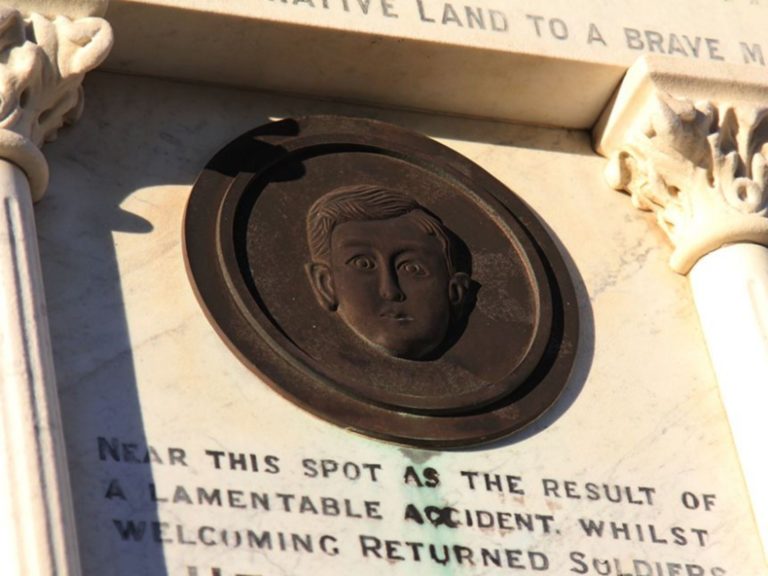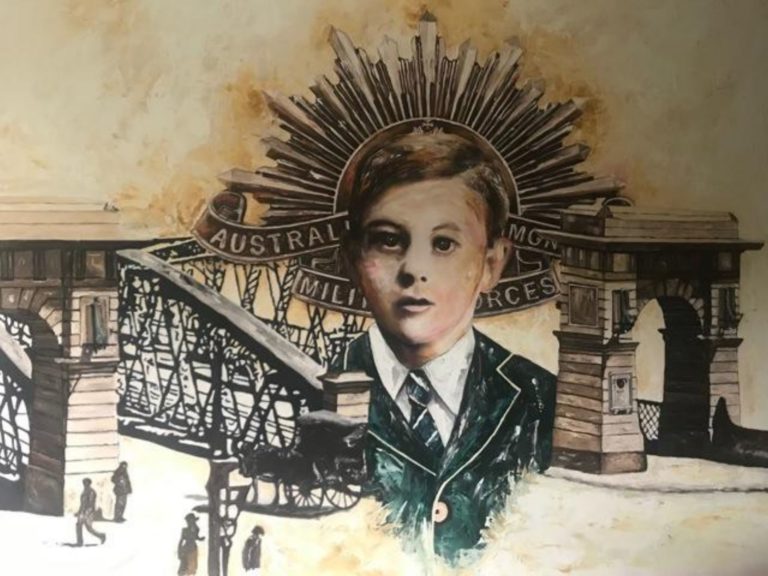Renowned Cypriot-Australian artist and graphic designer George Petrou has honoured a little-known story of patriotism and tragedy from 100 years ago – the story of Hector Vasyli.
Hector Vasyli was an 11-year-old Brisbane newspaper boy and altar boy in 1918. He was the son of a Cypriot-born father and Australian-born mother who ran the then Queensland Oyster Palace in South Brisbane, which stood a short distance from the then Victoria Bridge.
He was one of many who came regularly to the Bridge to welcome home the Australian soldiers who began returning from overseas as the First World War drew to a close. Young Hector used to save up his pocket money to buy gift for the returning soldiers – chocolates, flowers and cigarettes, which he would throw to the soldiers as they went by. But on that day on 9 June 1918, Hector would be killed, fatally injured by a vehicle in the military procession as it swerved to avoid hitting another car in the procession. Rushed to a nearby hospital, Hector died.
The community was so moved by Hector’s story that a stone and bronze memorial was installed on an abutment at the southern end of the Bridge. The memorial carries a likeness of Hector’s face in metal and the inscription:
“During his brief sojourn on Earth he devoted much of his time to patriotic work for Australian soldiers during the Great War. In his veins ran the heroic blood of Greece, and in the breast of a child he carried the heart of a man.”
READ MORE: Jim Claven’s ‘Lemnos and Gallipoli Revealed’ captures the ANZAC spirit

Members of Brisbane’s Hellenic community – including the local Hellenic RSL Sub-Branch – gather at Hector’s Memorial to lay a wreath in his memory every Anzac Day. The Memorial itself has been preserved due to the hard work of the Hellenic community, the Hellenic RSL Sub-Branch and Queensland’s Consul of Greece. While the Bridge itself was pulled down in 1969, the Bridge abutment was given heritage listening in 1992 and access to the abutment and memorial improved in 2015.
Fascinated by Hector’s story, George has researched the story over recent months with the aim of commemorating his story with a portrait. The focus of George’s painting is an image of Hector himself, along with the Anzac rising sun as the symbol of all Australian soldiers forming a sort of iconic backdrop to the young Hector. Also featured is an image of the original Victoria Bridge which no longer exists, taken from an original phototroph of it taken in 1896.
George told Neos Kosmos that he was proud to play a small part in recognising this forgotten Anzac story, a part of the Hellenic link to Anzac. One of the serendipities of the story and its connection to George is not only Hector and George’s joint Cypriot heritage but the fact that the road which crossed the Bridge was named Melbourne Street – George living in Melbourne!
READ MORE: On this Anzac Day… Let’s remember the medical staff at Lemnos and Salonika in WWI

“Here is a young boy, the son of a Cypriot migrant father and Australian mother, who was so moved by the return of the Anzacs to his native Brisbane that he wanted to make a personal welcome home. Tragically this motivation would lead to his death. This story says so much about those Australians of Hellenic background – of migration, of the joining of two stories, of the Hellenic and the Australian”, George said.
He added that his relatives and friends in Cyprus are so happy to hear of this moving story and glad that it is to be commemorated in this artistic way by a son of Cyprus who has made Australia his home.
George has gifted his commemorative portrait to the Museum of Brisbane, where it will soon by on permanent display.
George Petrou is well-known for his work commemorating Australia’s Victoria Cross awardees – and other famous Australian service personnel – in his many portraits. These include Matron Grace Wilson who served on the Island of Lemnos in 1915. They have been displayed across Australia, including at Melbourne’s Shrine of Remembrance. He is also responsible for the design of my recent publication Lemnos & Gallipoli Revealed. Those interested in obtaining postcard-sized reproductions of George’s artwork should contact me at jimclaven@yahoo.com.au.

Jim Claven is a trained historian, freelance writer, Secretary of the Lemnos Gallipoli Commemorative Committee and author of Lemnos & Gallipoli Revealed. In preparing this story he acknowledges the work of Christina Ealing-Godbold, senior research librarian at the State Library of Queensland and the report by Hailey Renault of ABC Radio Brisbane on the Hector Vasyli story.









